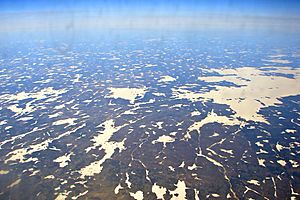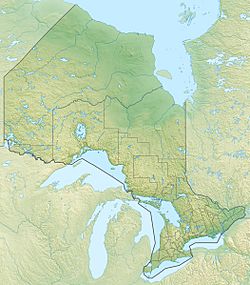Big Trout Lake facts for kids
Quick facts for kids Big Trout Lake |
|
|---|---|

Aerial view of Big Trout Lake (largest lake at centre right)
|
|
| Location | Northern Ontario |
| Coordinates | 53°45′N 90°00′W / 53.750°N 90.000°W |
| Primary inflows | Fawn River |
| Primary outflows | Fawn River |
| Basin countries | Canada |
| Max. length | 57 km (35 mi) |
| Max. width | 23 km (14 mi) |
| Surface area | 661 km2 (255 sq mi) |
| Surface elevation | 213 m (699 ft) |
| Islands | Big Island, Post Island |
Big Trout Lake is a very large lake located in the northern part of Ontario, Canada. It is known for its clear waters and natural beauty. The lake is an important part of the environment and home to many animals.
Contents
About Big Trout Lake
Big Trout Lake is one of the biggest lakes in Northern Ontario. It stretches about 57 kilometers (35 miles) long and 23 kilometers (14 miles) wide. The total area of the lake is about 661 square kilometers (255 square miles). This makes it a huge body of water!
Water Flow and Islands
The Fawn River plays a big role in Big Trout Lake. This river flows into the lake from the west side. It then flows out of the lake on the east side. This means the Fawn River both fills and drains the lake.
The lake has a few islands. Two of the main islands are called Big Island and Post Island. These islands add to the lake's unique look.
Home to a First Nation Community
Big Trout Lake is very important to the Kitchenuhmaykoosib Inninuwug First Nation. This is an Indigenous community in Canada. Their reserve, which is a special area of land set aside for them, is located on Post Island. This island is on the northern shore of the lake.
The community is also known by the same name as the lake, Big Trout Lake. The lake has been a central part of their lives for a very long time. It provides food, water, and a place to live.
Why is Big Trout Lake Important?
Big Trout Lake is important for several reasons. It is a vital part of the local ecosystem. Many types of fish live in its waters. Birds and other wildlife also depend on the lake.
The lake also holds cultural importance for the Kitchenuhmaykoosib Inninuwug First Nation. It is a place where their history and traditions are strong. The lake helps them continue their way of life.


